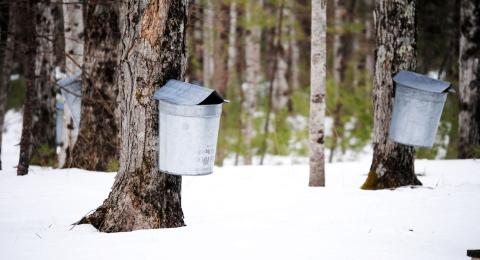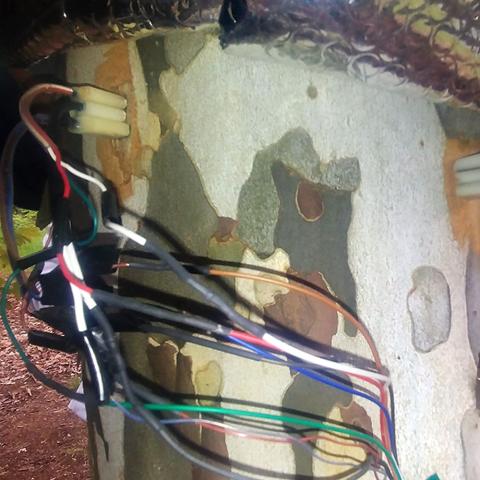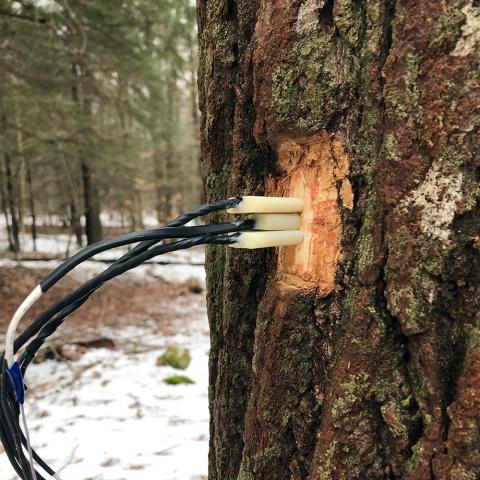Market potential of a more diverse syrup industry
Syrups produced from different tree species differ in flavor and, therefore, determining the perceived quality and taste preferences of different syrups among consumers and their willingness to pay for these syrups is important for assessing potential future market value. Results suggest that when consumers are provided with information about both the type of tree syrup they are tasting and the potential benefits of forest diversification, they are willing to pay $1.10 more per 12.7-oz bottle compared to consumers who did not receive this information. Therefore, consumer preferences might support the future diversification of sugarbushes, especially if labeling can successfully communicate the ecological benefits of forest diversification. Since overall consumer willingness to pay was still highest for maple syrup, producers may consider syrup blends that combine the taste benefits of maple syrup and the ecological benefits of diversified sugarbushes for promoting climate resilience.
Referenced resources
- Tonoloway Farm: Appalachian forest foods
- The Crooked Chimney:
- UNH Today: Experiment Station Presents Specialty Syrup Research Field Day
- New Leaf Tree Syrups:
- UNH Today: Q&A: Specialty Syrups
- From The Forest podcast: Sap & Syrup Beyond Maple with Crooked Chimney's David Moore
Ongoing research is analyzing the saps and syrups extracted from different non-maple tree species to better understand their chemical properties and potential health benefits. For example, foods with high phenolic compound content like maple syrup have been shown to have multiple health benefits, including being anti-inflammatory and anti-carcinogenic. Current hypotheses are that some non-maple syrups may yield phytochemical profiles with implications for consumer health. The research will also assess the degree to which diversification of the syrup industry can contribute to promoting greater climate resilience for both ecosystems and local communities.
This material is based on work supported by the NH Agricultural Experiment Station through joint funding from the USDA National Institute of Food and Agriculture (under Hatch award number 1022415) and the state of New Hampshire, as well as funding from the UNH Collaborative Research Excellence (CoRE) program. Authored by D. Moore, S. Atallah, S. Bigornia, M. Lima, M. Vadeboncoeur and H. Asbjornsen.
Key Findings
Non-maple species show different syrup chemical properties and sap flow patterns compared to sugar maple, potentially creating opportunities for new markets and operational structures.
When consumers are provided with information about different tree syrups and the potential benefits of forest diversification, they are willing to pay more compared to consumers without this information.
About the Co-Author
Heidi Asbjornsen, Professor of Natural Resources and the Environment
Contact information: Heidi.Asbjornsen@unh.edu, UNH Ecohydrology Lab
This research was published in the INSPIRED: A Publication of the New Hampshire Agricultural Experiment Station (Winter 2023)
Researchers: D. Moore, S. Atallah, S. Bigornia, M. Lima, M. Vadeboncoeur and H. Asbjornsen
Syrup production is an important agroforestry system in which sugar bushes—forests managed for syrup production—are actively managed to ensure large, healthy, sap-producing species such as sugar maple. While syrup is most commonly produced from maples, other types of trees can also be used. Novel syrups from birch and beech trees, for example, provide consumers with new flavors and new economic opportunities for producers. This research examines the potential for alternative syrup production in New England.
Syrup is most commonly produced from maples, but other types of trees can also be used. For example, there is a large birch syrup industry in Alaska and Canada, there are a handful of commercial walnut syrup producers in the U.S., and there is a commercial beech syrup producer in New York. These syrups are growing in popularity and typically sell for 4 to 6 times the price of maple syrup. Sugar maple has many advantages that make it particularly well-suited for syrup production but technologies developed to improve the efficiency of maple syrup production—such as vacuum pumps and reverse-osmosis filtration—have created possibilities for expanding to other species. Novel syrups provide consumers with new flavors and new economic opportunities for producers.
Maple syrup production is quintessential to New England's landscape, economy and culture, with historical roots as far back as the Native Americans and early European settlers. The industry is critical to sustaining vibrant local economies as well as the region’s cultural identity, social fabric, and environment. In 2021, the maple syrup industry was valued at over $84 million in the three northern New England states alone (Maine, New Hampshire and Vermont). However, because monocultures are inherently more vulnerable to uncertainties, the syrup industry’s overwhelming reliance on the sugar maple species increases its risk of major damage from extreme climate events, inter-annual weather variability, pests, pathogens and market shocks, among others.
Northeastern U.S. forests support a high diversity of promising sap-producing deciduous tree species, yet very little is known about the sap flow patterns and yield potential of these trees, the quality or potential market value of their syrups or the sugarbush management and sap processing techniques they require. Research that identifies these aspects could promote greater climate resilience, economic vitality and sustainability. As a first step toward this goal, this research has focused on understanding sap flow and sap pressurization dynamics in these species during winter dormancy, evaluating the chemical properties of different saps and syrups and assessing consumer preferences and market potential.
Syrup qualities and sap flow patterns
Data so far suggest that saps and syrups from non-maple tree species (birch, sycamore, beech, hophornbeam, basswood and alder) vary greatly in their chemical composition compared to sugar maple (Tables 1 and 2). For example, while sugar maple sap and syrup are dominated by sucrose, other species tend to produce saps and syrups that contain mostly fructose and glucose but very little sucrose. These differences in chemical composition have important implications for the processing of sap into syrup.
For instance, since fructose is known to break down at lower temperatures than glucose and sucrose, it may be important to limit the time that fructose-rich sap spends at high temperatures during processing. Reverse osmosis systems can aid in this process since they are used to concentrate sap without heat. Other qualities, such as phenolic content, can have positive implications for human health. Out of the five species included in the study, paper birch and American sycamore saps had the highest total phenolic contents, followed by American beech and sugar maple saps, and finally American hophornbeam sap.
Additionally, some species yield saps and syrups that are more acidic than those of sugar maples (Tables 1 and 2). Some acidic saps, like birch and sycamore, are known to dissolve many types of metals, which imparts metallic off-flavors to the syrups. One solution is to use only plastic, stainless steel and glass equipment to collect, store and process the saps and syrups from these trees. Another finding is that different tree species vary in the timing of their sap flow. For example, saps from American beech and London planetree—a hybrid sycamore (Platanus x acerifolia)—flow when temperatures cross the freeze-thaw threshold, such as maple sap. However, hophornbeam and birch have sap flows that occur later in the spring. Managing sugarbushes that include species with different sap flow patterns can be advantageous because resources, labor and expertise can be distributed across a longer time period and potentially used more efficiently.
Lastly, preliminary results show that saps from trees other than maples are much more diluted than sugar maple sap. As such, reverse osmosis systems will likely play an important role in their production.






